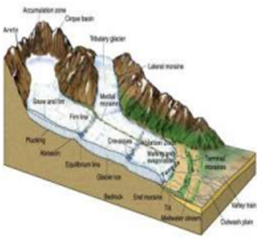Ethics Theory, TLP-UPSC Mains Answer Writing
Q. 4. Describe the major erosional and depositional landforms formed by glaciers. Support your answer with suitable examples. (250 words, 15 marks)
Introduction
Glacial landforms are features created by the action of glaciers through processes of erosion and deposition. These landforms are found in both current glaciated regions (like Antarctica, Greenland, and the Alps) and relict glaciated landscapes (e.g. Himalayas, Scandinavian highlands).
Body
Major Erosional Landforms
- Cirque: A bowl-shaped depression carved into a mountain by the head of a glacier. Example: Corrie Lochan in the Cairngorms, Scotland.
- Arete: A narrow ridge formed between two adjacent cirques. Example: Knife Edge in Mount Katahdin, USA.
- U-shaped Valley: Formed by the down-valley movement of glaciers, replacing a former V shaped river valley. Example: Yosemite Valley in California.
- Hanging Valley: A tributary valley that enters a U-shaped valley at a higher elevation, often with waterfalls. Example: Bridalveil Falls, Yosemite.
- Roche Moutonnée: A rock formation smoothed by glaciers on one side and Erosional and Depositional forms plucked on the other. Example: Found in Lake District, England.

Major Depositional Landforms
- Moraine: Accumulations of debris (till) deposited by a glacier. Types include lateral, terminal, and ground moraines. Example: Terminal moraine in the Snout of Gangotri Glacier.
- Drumlin: Smooth, elongated hills made of glacial till shaped by ice flow. Example: Drumlins in the Valparai region, Tamil Nadu.
- Esker: A winding ridge formed by glacial meltwater streams depositing sediments under the ice. Example: Kettle Moraine region, USA.
- Kame: Irregularly shaped mounds of sand and gravel formed by glacial meltwater. Example: Found in parts of Alberta, Canada.
- Outwash Plain: A flat area composed of sediments deposited by glacial meltwater beyond the terminal moraine. Example: Sandur plains in Iceland.
Conclusion
Glacial erosion and deposition shape landscapes uniquely, leaving lasting imprints visible even long after glaciation has ceased. These landforms are essential for understanding past climatic conditions and glacial extents.













